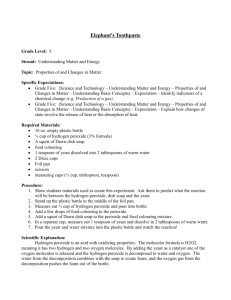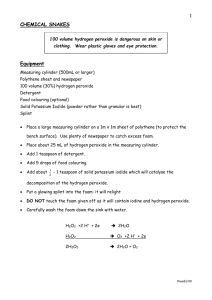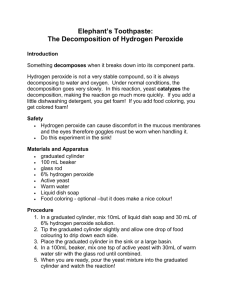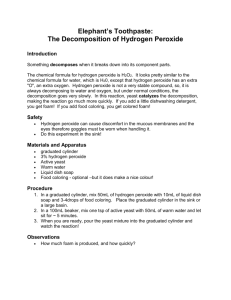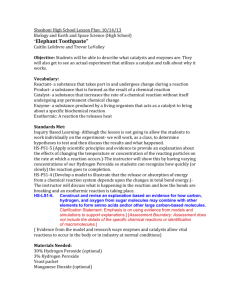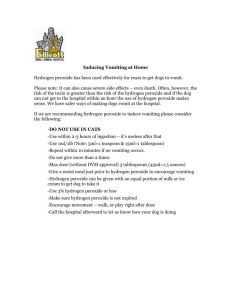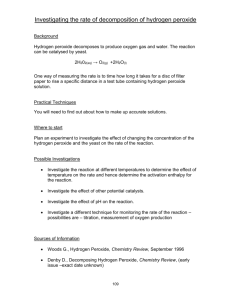tiny bubbles Perform..
advertisement
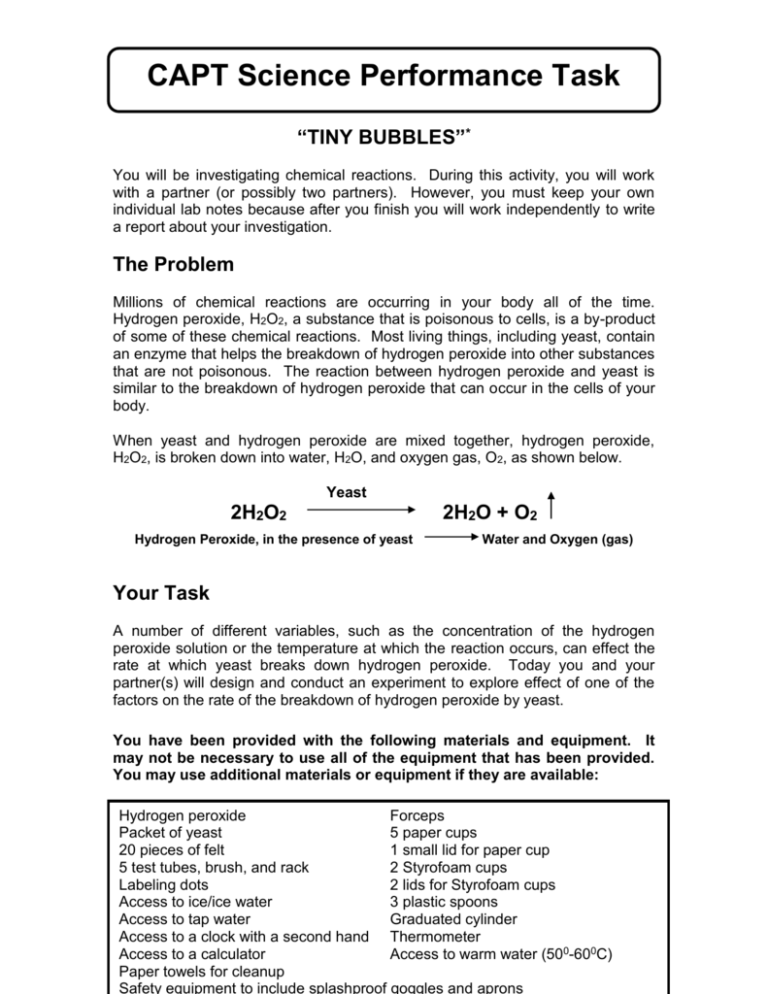
CAPT Science Performance Task “TINY BUBBLES”* You will be investigating chemical reactions. During this activity, you will work with a partner (or possibly two partners). However, you must keep your own individual lab notes because after you finish you will work independently to write a report about your investigation. The Problem Millions of chemical reactions are occurring in your body all of the time. Hydrogen peroxide, H2O2, a substance that is poisonous to cells, is a by-product of some of these chemical reactions. Most living things, including yeast, contain an enzyme that helps the breakdown of hydrogen peroxide into other substances that are not poisonous. The reaction between hydrogen peroxide and yeast is similar to the breakdown of hydrogen peroxide that can occur in the cells of your body. When yeast and hydrogen peroxide are mixed together, hydrogen peroxide, H2O2, is broken down into water, H2O, and oxygen gas, O2, as shown below. Yeast 2H2O2 Hydrogen Peroxide, in the presence of yeast 2H2O + O2 Water and Oxygen (gas) Your Task A number of different variables, such as the concentration of the hydrogen peroxide solution or the temperature at which the reaction occurs, can effect the rate at which yeast breaks down hydrogen peroxide. Today you and your partner(s) will design and conduct an experiment to explore effect of one of the factors on the rate of the breakdown of hydrogen peroxide by yeast. You have been provided with the following materials and equipment. It may not be necessary to use all of the equipment that has been provided. You may use additional materials or equipment if they are available: Hydrogen peroxide Forceps Packet of yeast 5 paper cups 20 pieces of felt 1 small lid for paper cup 5 test tubes, brush, and rack 2 Styrofoam cups * 1998 CAPT Science Performance Test, Connecticut State Department of Education, Hartford, Labeling dots 2 lids for Styrofoam cups 1998. Access to ice/ice water 3 plastic spoons Access to tap water Graduated cylinder Access to a clock with a second hand Thermometer Access to a calculator Access to warm water (500-600C) Paper towels for cleanup Steps to Follow Part A Observe what happens when yeast is added to hydrogen peroxide. Follow the instructions below. 1. In a paper cup, combine one packet of yeast with 100 mL of tap water at room temperature and mix well with a plastic spoon. This will serve as your supply of yeast solution for the experiment. You may want to cover the paper cup containing the yeast solution with the small lid to reduce the odor. 2. Pinch the rim of a paper cup to make a spout for pouring. In a paper cup dilute 10 mL of hydrogen peroxide with 190 mL of room temperature tap water. This will serve as your supply of hydrogen peroxide solution for the experiment. 3. Fill one test tube about ¾ full with the hydrogen peroxide solution. Using the forceps, soak a piece of felt in the yeast solution and then drop it into the test tube containing hydrogen peroxide solution. The felt should sink to the bottom of the test tube. As the yeast helps break down the hydrogen peroxide, oxygen gas bubbles are formed on the felt and it rises to the top as illustrated in the diagram below. In this experiment, you will measure how long it takes for the piece of felt soaked with yeast solution to sink and rise in the test tube. The amount of time it takes for the felt to sink and rise in the test tube indicates how quickly oxygen bubbles are being formed as the hydrogen peroxide is broken down. Part B 1. You will now select one variable, either temperature of the concentration of the hydrogen peroxide solution. You will explore the effect of this variable on the rate of breakdown of hydrogen peroxide by yeast. 2. In your own words, clearly state the problem you are going to investigate. Include a clear definition of the independent and dependent variables that will be studied. 3. Design an experiment to solve the problem. Your experimental design should match your statement of the problem, should control the variables, and should be clearly described so that someone else could easily replicate your experiment. Include a control if appropriate. Show your design to your teacher before you begin your experiments. 4. After receiving permission from your teacher, work with your partner to carry out your experiments. Your teacher’s approval does not necessarily mean that your teacher thinks your experiments are well designed. It simply means that in your teacher’s judgement your experiments are not dangerous or likely to cause an unnecessary mess. 5. While conducting your experiments, take careful notes on the pages provided. Space is also provided for charts, tables, or graphs. Your notes will not be scored, but they will be helpful to you later as you work independently to write about your experiments and the results. You must keep your own notes because you will not work with your lab partner when you write your report. When you have finished your experiments, your teacher will give you instructions for clean-up procedures, including proper disposal of all materials. Directions for Writing Your Laboratory Report Working on your own, summarize your experiments and results. You may use your own notes that you took previously while working with your partner. You may wish to write a first draft of your lab report on scratch paper. Space for your final report is provided. You will have approximately 30 minutes to complete your report Your report should include the following general Areas: A clear statement of the problem you investigated. Include a clear identification of the independent and dependent variables that were studied. A description of the experiment you carried out. Your description should be clear and complete enough so that someone could easily replicate your experiment. The results of your experiment. Tables, charts, and/or graphs should be used where appropriate and should be properly labeled. Space for your data is provided. Your conclusions from your experiment. should be fully supported by data. Comments about how valid you think your conclusions are. In other words, how much confidence do you have in your results and conclusions? Any factors that contribute to a lack of confidence in the results or conclusions should be discussed. Also, include the ways that your experiment could be improved if you were to do it again. Your conclusions



